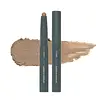What's inside
What's inside
 Key Ingredients
Key Ingredients

 Benefits
Benefits

 Concerns
Concerns

 Ingredients Side-by-side
Ingredients Side-by-side

Ethylhexyl Palmitate
EmollientCyclopentasiloxane
EmollientSilica
AbrasiveSynthetic Wax
AbrasiveCaprylic/Capric Triglyceride
MaskingCI 77891
Cosmetic ColorantDimethicone
EmollientC13-15 Alkane
SolventTrimethylsiloxysilicate
EmollientVinyl Dimethicone/Methicone Silsesquioxane Crosspolymer
Isododecane
EmollientCetyl PEG/PPG-10/1 Dimethicone
EmulsifyingPolyglyceryl-3 Polyricinoleate
EmulsifyingParaffin
PerfumingJojoba Esters
EmollientSorbitan Isostearate
EmulsifyingVp/Hexadecene Copolymer
Dimethicone/Vinyl Dimethicone Crosspolymer
Skin ConditioningCI 77499
Cosmetic ColorantMicrocrystalline Wax
Emulsion StabilisingDisteardimonium Hectorite
StabilisingCI 77492
Cosmetic ColorantCI 77491
Cosmetic ColorantTriethoxycaprylylsilane
Aluminum Hydroxide
EmollientTocopherol
AntioxidantPentaerythrityl Tetra-Di-T-Butyl Hydroxyhydrocinnamate
AntioxidantEthylhexyl Palmitate, Cyclopentasiloxane, Silica, Synthetic Wax, Caprylic/Capric Triglyceride, CI 77891, Dimethicone, C13-15 Alkane, Trimethylsiloxysilicate, Vinyl Dimethicone/Methicone Silsesquioxane Crosspolymer, Isododecane, Cetyl PEG/PPG-10/1 Dimethicone, Polyglyceryl-3 Polyricinoleate, Paraffin, Jojoba Esters, Sorbitan Isostearate, Vp/Hexadecene Copolymer, Dimethicone/Vinyl Dimethicone Crosspolymer, CI 77499, Microcrystalline Wax, Disteardimonium Hectorite, CI 77492, CI 77491, Triethoxycaprylylsilane, Aluminum Hydroxide, Tocopherol, Pentaerythrityl Tetra-Di-T-Butyl Hydroxyhydrocinnamate
Isononyl Isononanoate
EmollientTriethylhexanoin
MaskingSilica
AbrasiveDimethicone
EmollientSynthetic Wax
AbrasiveOctyldodecanol
EmollientDimethicone Crosspolymer
Emulsion StabilisingMicrocrystalline Wax
Emulsion StabilisingCaprylyl Glycol
EmollientHydroxyacetophenone
AntioxidantPolyhydroxystearic Acid
EmulsifyingTriethoxycaprylylsilane
Tocopheryl Acetate
AntioxidantCI 77891
Cosmetic ColorantCI 77491
Cosmetic ColorantCI 77492
Cosmetic ColorantCI 77499
Cosmetic ColorantCI 15850
Cosmetic Colorant
 Reviews
Reviews

Ingredients Explained
These ingredients are found in both products.
Ingredients higher up in an ingredient list are typically present in a larger amount.
Ci 77491 is also hydrated iron III oxide. It's sole purpose is to give a red/pink hue to products.
Iron III oxides are classified as inorganic chemicals for coloring.
Synthetically created Ci 77491 is considered safer than those naturally found. This is because the synthetically created version may contain less impurities. Iron oxides are generally non-toxic and non-allergenic.
Learn more about CI 77491Ci 77492 is also hydrated iron III oxide. It's sole purpose is to give a yellow hue to products.
Iron III oxides are classified as inorganic chemicals for coloring.
Synthetically created Ci 77492 is considered safer than those naturally found. This is because the synthetically created version may contain less impurities. Iron oxides are generally non-toxic and non-allergenic.
Learn more about CI 77492Ci 77499 is also hydrated iron III oxide. It is created from mixing red and black iron oxides. This helps give shades of darkness to a product.
Iron III oxides are classified as inorganic chemicals for coloring.
Ci 77891 is a white pigment from Titanium dioxide. It is naturally found in minerals such as rutile and ilmenite.
It's main function is to add a white color to cosmetics. It can also be mixed with other colors to create different shades.
Ci 77891 is commonly found in sunscreens due to its ability to block UV rays.
Learn more about CI 77891Dimethicone is a type of synthetic silicone created from natural materials such as quartz.
What it does:
Dimethicone comes in different viscosities:
Depending on the viscosity, dimethicone has different properties.
Ingredients lists don't always show which type is used, so we recommend reaching out to the brand if you have questions about the viscosity.
This ingredient is unlikely to cause irritation because it does not get absorbed into skin. However, people with silicone allergies should be careful about using this ingredient.
Note: Dimethicone may contribute to pilling. This is because it is not oil or water soluble, so pilling may occur when layered with products. When mixed with heavy oils in a formula, the outcome is also quite greasy.
Learn more about DimethiconeMicrocrystalline Wax is created by de-oiling petroleum. It is highly refined and purified before being added to cosmetics.
Microcrystalline Wax is used to enhance the texture and create even consistency. It helps stabilize a product by preventing ingredients from separating.
Silica, also known as silicon dioxide, is a naturally occurring mineral. It is used as a fine, spherical, and porous powder in cosmetics.
Though it has exfoliant properties, the function of silica varies depending on the product.
The unique structure of silica enhances the spreadability and adds smoothness, making it a great texture enhancer.
It is also used as an active carrier, emulsifier, and mattifier due to its ability to absorb excess oil.
In some products, tiny microneedles called spicules are made from silica or hydrolyzed sponge. When you rub them in, they lightly polish away dead skin layers and enhance the penetration of active ingredients.
Learn more about SilicaSynthetic Wax is created from fossil fuels such as natural gas. It is used to enhance texture, adjust pH, and as an occlusive.
It may also be used as an abrasive ingredient to exfoliate the skin.
Synthetic Wax may not be fungal acne safe.
Learn more about Synthetic WaxTriethoxycaprylylsilane is a silicone used to bind and stabilize ingredients.
As an emulsifier, it helps prevent ingredients from separating. This can help elongate the shelf life of products.
Triethoxycaprylylsilane is often used to coat mineral sunscreens ingredients to help give a better feel. It also helps reduce oxidative stress in sunscreens.
Learn more about Triethoxycaprylylsilane